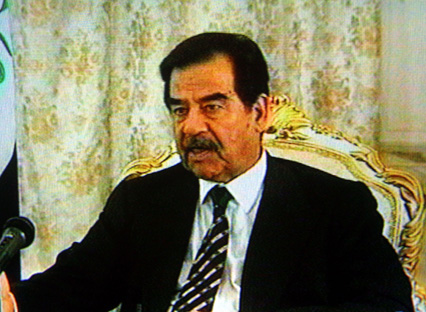How did the Gulf War start?
As tensions rise in the region The Week explores why Saddam Hussein's Iraqi forces invaded Kuwait nearly 30 years ago

The US is sending an additional 1,000 troops to the Middle East as tensions continue to escalate between Washington and Iran.
The US and its regional allies have accused Tehran of two recent attacks on oil tankers in the Gulf of Oman. It comes amid a ramping up of rhetoric between the two countries following Donald Trump’s decision to withdraw from the landmark 2015 nuclear deal and the introduction of biting US sanctions which have pushed Iran’s economy to the brink of collapse.
“The recent Iranian attacks validate the reliable, credible intelligence we have received on hostile behaviour by Iranian forces and their proxy groups that threaten United States personnel and interests across the region,” acting Defense Secretary Pat Shanahan said in a statement announcing the deployment.
The Week
Escape your echo chamber. Get the facts behind the news, plus analysis from multiple perspectives.

Sign up for The Week's Free Newsletters
From our morning news briefing to a weekly Good News Newsletter, get the best of The Week delivered directly to your inbox.
From our morning news briefing to a weekly Good News Newsletter, get the best of The Week delivered directly to your inbox.
Despite Shanahan’s claim that the troop build-up was “for defensive purposes to address air, naval, and ground-based threats in the Middle East”, the escalation has raised the spectre of a third major conflict in the Gulf in less than 30 years.
The first of these saw Iraqi President Saddam Hussein’s forces invade its oil-rich neighbour Kuwait in 1990. The move drew international condemnation and triggered a conflict waged by coalition forces from 35 nations led by the US.
The Gulf War lasted just seven months, with Hussein’s forces heavily outnumbered by the coalition, in what was then the largest American military action in the Middle East since the Second World War.
Throughout the 1980s, the US and the UK had “looked on as Iraq and Iran fought each other in a deadly war of attrition”, says The Guardian. Though officially neutral, Britain armed Hussein and continued to do so until the day he invaded Kuwait, on 2 August 1990, the newspaper adds.
A free daily email with the biggest news stories of the day – and the best features from TheWeek.com
American intelligence, “believing Iraq exhausted by the recently concluded, decade-long Iran-Iraq war, had expected only posturing or limited aggression” from Hussein, says the Washington DC-based Hudson Institute think tank.
Instead, Hussein’s invasion on Kuwait would lead to an international conflict. So what happened?
Iraq-Kuwait tensions
The end of the Iraqi war with Iran in 1988 deepened latent tensions between Iraq and its wealthy neighbour Kuwait. Hussein repeatedly urged the Kuwaitis to waive the Iraqi debt accumulated from the war, some $30bn (£23bn), but was refused.
Meanwhile, crude oil prices dropped in July 1990 from $18 to $12 per barrel, seriously hitting the Iraqi economy. Kuwait “had increased its oil output to the disadvantage of other oil producers, flooding the market with surplus barrels and pushing down prices”, says Germany newspaper Deutsche Welle.
Iraq complained about Kuwait’s tactics to the Arab League and openly threatened to take military action. According to The New York Times, Hussein threatened force against Kuwait and the United Arab Emirates (UAE), saying: “The policies of some Arab rulers are American... They are inspired by America to undermine Arab interests and security.”
In response, the US sent aerial refuelling planes and combat ships to the Persian Gulf. With tensions in the region rising, the Arab League organised talks between Iraq, Kuwait and the UAE, which took place on 31 July in Jeddah, Saudi Arabia.
The invasion
The result of the Jeddah talks was an Iraqi demand for $10bn (£7.7bn) to cover the lost oil revenues; Kuwait offered $9bn (£6.9bn). The Iraqi response was to immediately order the invasion, which started with the bombing of Kuwait’s capital, Kuwait City.
At the time, the Kuwaiti military is believed to have numbered 16,000 men, arranged into three armoured, one mechanised infantry and one under-strength artillery brigade. By contrast, with around a million soldiers, the Iraq Army was the world’s fourth-largest military force - in part thanks to the weapons that Western nations had to Iraq in order to aid in its fight against Iran.
On 3 August, the United Nations Security Council called for Iraq to withdraw from Kuwait. Three days later, the council imposed a worldwide ban on trade with Iraq.
Kuwait was formally annexed on 8 August, a development that posed a potential threat to neighbouring Saudi Arabia, the world’s largest oil producer and exporter. This “prompted the US and its western European Nato allies to rush troops to Saudi Arabia to deter a possible attack”, says the Encyclopedia Britannica. Egypt and several other Arab nations joined the anti-Iraq coalition and contributed forces to the military build-up, known as Operation Desert Shield.
On 29 November ,the UN Security Council authorised the use of force against Iraq if it did not withdraw from Kuwait by 15 January 1991. But Hussein failed to budge and combat broke out on 16 January 1991, with US and British warplanes bombing Iraqi armour and troop formations.
The war would end with an Iraqi defeat and retreat from Kuwait on 28 February.
-
 8 restaurants that are exactly what you need this winter
8 restaurants that are exactly what you need this winterThe Week Recommends Old standards and exciting newcomers alike
-
 ‘This is a structural weakening of elder protections’
‘This is a structural weakening of elder protections’Instant Opinion Opinion, comment and editorials of the day
-
 4 tips to safeguard your accounts against data breaches
4 tips to safeguard your accounts against data breachesThe Explainer Even once you have been victimized, there are steps you can take to minimize the damage